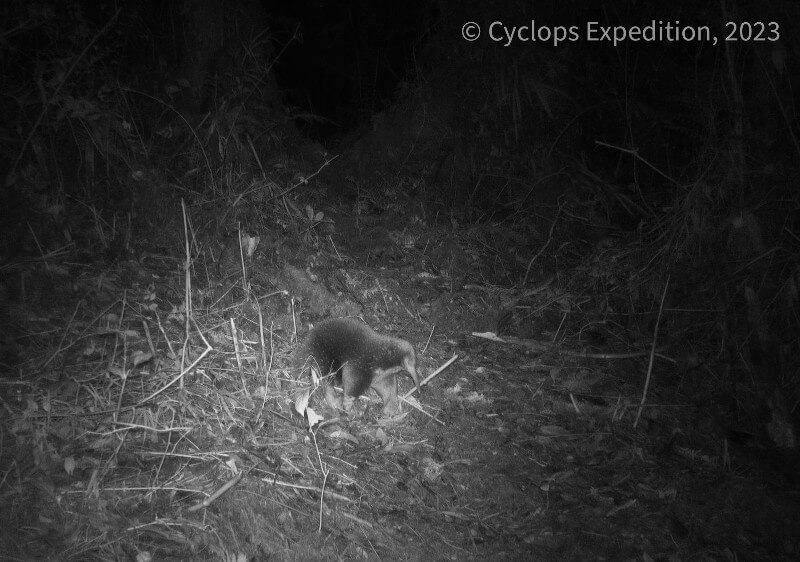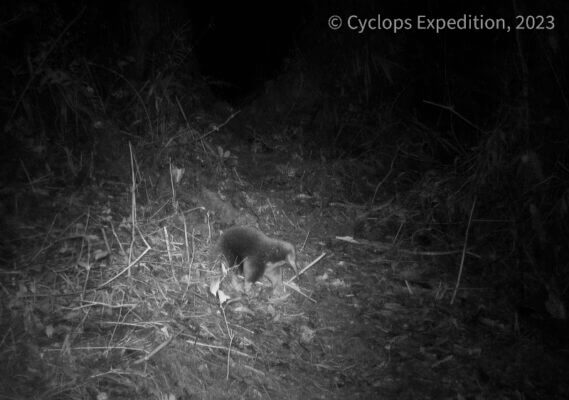

More than sixty years after it was last recorded, an expedition team has rediscovered an iconic, egg-laying mammal in one of the most unexplored regions of the world. Attenborough’s long-beaked echidna, named after famed broadcaster Sir David Attenborough, was captured for the first time in photos and video footage using remote trail cameras set up in the Cyclops Mountains of Indonesia’s Papua Province.
Alongside the echidna’s rediscovery, the expedition – a partnership between the University of Oxford, Indonesian NGO Yayasan Pelayanan Papua Nenda (YAPPENDA), Cenderawasih University (UNCEN), Papua BBKSDA, and the National Research and Innovation Agency of Indonesia (BRIN), Re:Wild – made many other remarkable finds. These included Mayr’s honeyeater, a bird lost to science since 2008; an entirely new genus of tree-dwelling shrimp; countless new species of insects; and a previously unknown cave system. This was despite the difficulties posed by extremely inhospitable terrain, including venomous animals, blood-sucking leeches, malaria, earthquakes, and exhausting heat.
Recorded by science only once in 1961, Attenborough’s long-beaked echidna is a monotreme: an evolutionarily distinct group of egg-laying mammals that includes the platypus. This echidna species is so special because it is one of only five remaining species of monotremes, the sole guardians of this remarkable branch of the tree of life. Echidnas are notoriously difficult to find since they are nocturnal, live in burrows, and tend to be very shy. Attenborough’s long-beaked echidna has never been recorded anywhere outside the Cyclops Mountains, and is currently classified as Critically Endangered on the IUCN Red List of Threatened Species
To give themselves the best chance of finding one, the team deployed over 80 trail cameras, making multiple ascents of the mountains, and climbing more than 11,000 meters (more than the height of Everest) in the process. For almost the entire four weeks that the team spent in the forest, the cameras recorded no sign of the echidna. On the last day, with the last images on the final memory card, the team obtained their shots of the elusive mammal – the first ever photographs of Attenborough’s echidna. The identification of the species was later confirmed by Professor Kristofer Helgen, mammalogist and chief scientist and director of the Australian Museum Research Institute (AMRI).
Dr James Kempton, a biologist from the University of Oxford who conceived of and led the expedition, said: ‘Attenborough’s long-beaked echidna has the spines of a hedgehog, the snout of an anteater, and the feet of a mole. Because of its hybrid appearance, it shares its name with a creature of Greek mythology that is half human, half serpent. The reason it appears so unlike other mammals is because it is a member of the monotremes – an egg-laying group that separated from the rest of the mammal tree-of-life about 200 million years ago.’
‘The discovery is the result of a lot of hard work and over three and a half years of planning,’ he added. ‘A key reason why we succeeded is because, with the help of YAPPENDA, we have spent years building a relationship with the community of Yongsu Sapari, a village on the north coast of the Cyclops Mountains. The trust between us was the bedrock of our success because they shared with us the knowledge to navigate these treacherous mountains, and even allowed us to research on lands that have never before felt the tread of human feet.’
Alongside searching for the echidna, the expedition carried out the first comprehensive assessment of invertebrate, reptile, amphibian, and mammal life in the Cyclops Mountains. With the support of local guides in the expedition team, the scientists were able to create makeshift labs in the heart of the jungle with benches and desks made from forest branches and vines.
By combining scientific techniques with the Papuan team members’ experience and knowledge of the forest, the team made a wealth of new discoveries. These included several dozens of insect species completely new to science and the rediscovery of Mayr’s honeyeater (Ptiloprora mayri), a bird lost to science since 2008 and named after famed evolutionary biologist Ernst Mayr.
An extraordinary finding was an entirely new genus of ground and tree-dwelling shrimp. ‘We were quite shocked to discover this shrimp in the heart of the forest, because it is a remarkable departure from the typical seaside habitat for these animals,’ said Dr Leonidas-Romanos Davranoglou (a Leverhulme Trust Postdoctoral Fellow at the Oxford University Museum of Natural History), lead entomologist for the expedition. ‘We believe that the high level of rainfall in the Cyclops Mountains means the humidity is great enough for these creatures to live entirely on land.’
The team also revealed a treasure trove of underground species, including blind spiders, blind harvestman, and a whip scorpion, all new to science, in a previously unexplored cave system. This astonishing discovery was made on one of the sacred peaks above Yongsu Sapari where the team had been given special permission to do research. People rarely tread here, and the striking cave system was chanced upon when one team member fell through a moss-covered entrance.
Extremely challenging and, at times, life-threatening conditions were at the background of these discoveries. During one of the trips to the cave system, a sudden earthquake forced the team to evacuate. Dr Davranoglou broke his arm in two places, one member contracted malaria, and another had a leech attached to his eye for a day and a half before it was finally removed at a hospital. Throughout the expedition, members were beset by biting mosquitoes and ticks, and faced constant danger from venomous snakes and spiders. Making any progress through the jungle was a slow and exhausting process, with the team sometimes having to cut paths where no humans had ever been before.
‘Though some might describe the Cyclops as a “Green Hell”, I think the landscape is magical, at once enchanting and dangerous, like something out of a Tolkien book’ said Dr Kempton. ‘In this environment, the camaraderie between the expedition members was fantastic, with everyone helping to keep up morale. In the evening, we exchanged stories around the fire, all the while surrounded by the hoots and peeps of frogs.’
Rediscovering the echidna is only the beginning of the expedition’s mission. Attenborough’s long-beaked echidna is the flagship animal of the Cyclops Mountains and a symbol of its extraordinary biodiversity. The team hope that its rediscovery will help bring attention to the conservation needs of the Cyclops, and Indonesian New Guinea more generally, and they are committed to supporting long-term monitoring of the echidna. Key to this work is NGO YAPPENDA, whose mission is to protect the natural environment of Indonesian New Guinea through empowerment of Indigenous Papuans. As part of the expedition team, members of YAPPENDA helped train six students from UNCEN in biodiversity surveys and camera trapping during the expedition.
Dr Davranoglou said: ‘Tropical rainforests are among the most important and most threatened terrestrial ecosystems. It is our duty to support our colleagues on the frontline through exchanging knowledge, skills, and equipment.’
With the team having only sorted a fraction of the material collected on the expedition, they expect that the coming months will yield even more new species. The intention is to name many of these after the Papuan members of the expedition.
Besides animal specimens, the team also collected over 75 kg of rock samples for geological analysis, which was led by the expedition’s chief geologist, Max Webb, from Royal Holloway University, London. These could help answer many questions about how and when the Cyclops Mountains originally formed. The mountains are believed to have formed when an island arc in the Pacific Ocean collided with the New Guinea mainland about 10 million years ago. Combined with the biological findings, this geological work will help the team understand how the extraordinary biodiversity of the Cyclops came to be.